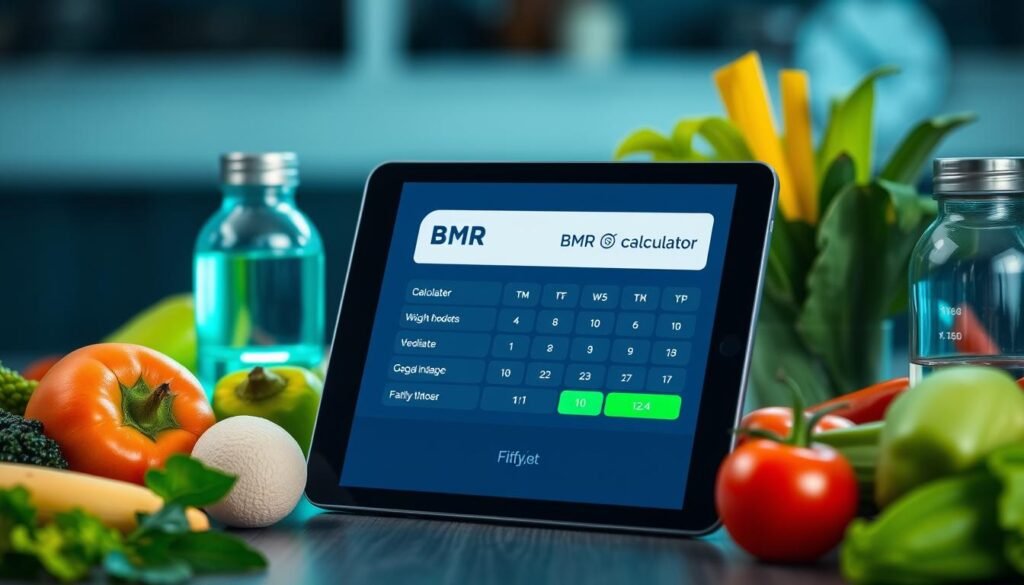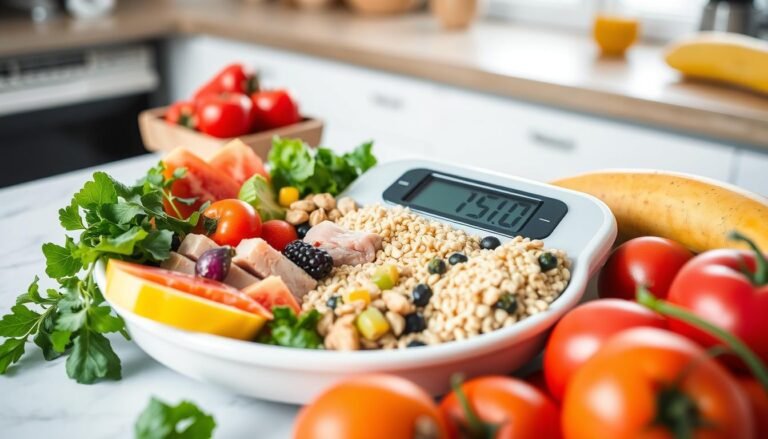Starting your weight loss journey begins with knowing your body’s calorie needs. The Basal Metabolic Rate BMR calculator is a key tool for this. It shows how many calories your body burns when you’re not moving, helping you plan your weight loss.
With a BMR calculator, you learn how many calories your body needs. This lets you make a calorie deficit plan for losing weight. Whether you want to lose weight or keep it off, knowing your BMR is crucial.

Key Takeaways
- Understand the importance of Basal Metabolic Rate (BMR) in weight loss
- Discover how a BMR calculator can help you determine your daily calorie needs
- Learn how to create a personalized calorie deficit for effective weight management
- Gain insights into your body’s unique calorie requirements
- Unlock the power of BMR knowledge for sustainable weight loss
Understanding BMR: The Foundation of Weight Loss Success
Understanding your basal metabolic rate (BMR) is key to lasting weight loss success. BMR is the number of calories your body burns at rest, without moving. It’s crucial for burning calories and fat, making it the base for effective weight management.
How Your Body Burns Calories at Rest
Your body’s metabolism works hard to turn food into energy, even when you’re still. This calorie burning mainly happens through your BMR. It makes up about 70% of your daily energy use.
Factors Affecting Basal Metabolic Rate
- Age: As we age, our metabolism slows down. This makes it harder to burn calories and keep a healthy body composition analysis.
- Gender: Men usually have a higher metabolism rate than women. This is because of their more muscle mass and other differences.
- Weight and Height: People with more weight and height have a higher BMR. They need more energy to support their larger size.
- Muscle Mass: Muscle burns more calories than fat. So, those with more muscle tend to burn fat faster.
Knowing these factors that affect your BMR is vital. It helps you create a weight loss plan that works with your body’s natural calorie-burning abilities.
“Unlocking the power of your BMR is the first step towards sustainable weight loss and a healthier, more energetic you.”
How to Calculate Your BMR for Effective Weight Loss
Figuring out your Basal Metabolic Rate (BMR) is key to losing weight. Your BMR shows how many calories your body burns when you’re not moving. Knowing your BMR helps you figure out how many calories you should eat each day.
There are two main ways to find your BMR: the Harris-Benedict equation and the Mifflin-St Jeor equation. Both use your age, gender, height, and weight to give you a BMR estimate that’s just for you.
- The Harris-Benedict equation for women: BMR = 655 + (9.6 × weight in kg) + (1.8 × height in cm) – (4.7 × age in years).
- The Mifflin-St Jeor equation for women: BMR = (10 × weight in kg) + (6.25 × height in cm) – (5 × age in years) – 161.
But, using an online BMR calculator for weight loss is easier and more accurate. These calculators make it simple to get a BMR estimate that fits you perfectly.
“Knowing your BMR is the first step in creating a sustainable calorie intake and fitness goals for successful weight loss.”
After finding your BMR, you can figure out how many calories you need to lose weight. This info helps you set the right calorie intake and fitness goals. It ensures you lose weight in a healthy and lasting way.
| Formula | Factors Considered | Advantages |
|---|---|---|
| Harris-Benedict Equation | Age, gender, height, weight | Widely used and recognized, provides a good baseline estimate |
| Mifflin-St Jeor Equation | Age, gender, height, weight | Considered more accurate than the Harris-Benedict equation for some individuals |
| Online BMR Calculator | Age, gender, height, weight, activity level | Convenient, provides a personalized estimate, often more accurate than manual calculations |
The Science Behind BMR and Calorie Deficit
Understanding the balance between your Basal Metabolic Rate (BMR) and calorie intake is key to losing weight. A calorie deficit is the core of managing weight effectively. By grasping this concept, you can achieve healthy weight loss.
Creating the Perfect Calorie Deficit
To create a calorie deficit, eat fewer calories than your body burns. Your BMR plays a crucial role here. It shows how many calories your body needs at rest to keep your weight the same. Then, cut your daily calorie intake by 500-1000 calories to start losing weight without harming your metabolism.
Metabolic Adaptations During Weight Loss
- As you lose weight, your BMR may decrease due to a reduction in overall body size and muscle mass.
- Your body may also adapt by slowing down its metabolism to conserve energy, making weight loss more challenging.
- Regularly reassessing your BMR and adjusting your calorie intake accordingly can help you overcome these metabolic adaptations.
Understanding Energy Balance
The secret to lasting weight loss is a healthy energy balance. Make sure you eat fewer calories than your total daily energy expenditure (TDEE). TDEE includes your BMR and any physical activity. This way, you can create a calorie deficit and lose weight steadily. Use a tdee and macronutrient breakdowns calculator to lose weight to track your progress and make necessary changes.
The healthy weight loss journey is unique to each person. Learning about BMR and calorie deficits lets you craft a plan that fits your body and lifestyle perfectly.
TDEE Calculator: Moving Beyond Basic BMR
Understanding your Basal Metabolic Rate (BMR) is just the start for weight loss. To really get the most out of your fitness and diet, you need to look deeper at your Total Daily Energy Expenditure (TDEE). The TDEE calculator gives a fuller picture of your calorie needs, considering your activity and lifestyle.
The TDEE goes beyond BMR by including calories burned through fitness tracking, macro tracking, and your diet plans. It looks at your activity level to show how many calories you need to stay the same, gain, or lose weight.
Using a TDEE calculator can change your weight loss game. It helps you set calorie goals that are just right for losing fat. This way, you can adjust your diet and workouts to meet your goals.
“The TDEE calculator is a powerful tool that takes the guesswork out of weight loss. By understanding your true calorie needs, you can create a personalized plan that leads to lasting results.”
Using the TDEE calculator is a big step up from just knowing your BMR. It lets you fine-tune your fitness tracking, macro tracking, and diet planning for better results.

BMR Calculator for Weight Loss: Your Personal Guide
Starting a weight loss journey is both thrilling and challenging. Understanding your basal metabolic rate (BMR) is key. This guide will help you use a BMR calculator to manage your weight effectively.
Using the Calculator Effectively
To get the best from a BMR calculator, pay close attention to the details. You’ll need to enter your age, gender, height, weight, activity level, and lifestyle. This information helps the BMR calculator set a daily calorie goal for you.
- Your age, gender, and height
- Your current weight
- Your activity level and lifestyle factors
With the right data, the BMR calculator can show your daily calorie needs. This helps set a weight loss plan that’s just right for you.
Interpreting Your Results
After entering your details, the BMR calculator will give you a report. It will show your daily calorie needs and how much you burn at rest. It also considers your activity level.
Knowing these numbers is key to setting achievable weight loss goals. It helps you stay on track without extreme dieting. This way, you can lose weight at a healthy pace.
The BMR calculator is a great tool, but it’s not for everyone. Your metabolism, muscle, and hormones can change your calorie needs. Be ready to adjust your plan as you go. If you need more help, talk to a healthcare expert.
Macronutrient Breakdown for Optimal Fat Loss
Shedding unwanted pounds is not just about knowing your basal metabolic rate (BMR). It’s also about finding the right balance of macronutrients. Counting macronutrients is key to any good weight loss plan. It helps you stay in calorie deficit while keeping your muscle mass.
To lose fat well, you need to know the best macronutrient ratios for your BMR and goals. A good macronutrient mix supports your body’s fat-burning and gives you the right fuel for your activities.
Protein Power
Protein is vital for keeping muscle while losing weight. Aim for 0.7-1 gram of protein per pound of desired body weight. This helps keep your muscle and boosts your metabolism.
Carbohydrates for Energy
Carbs are your main energy source. Choose complex, fiber-rich carbs for lasting energy and to stay full. Try to get 30-40% of your calories from carbs.
Healthy Fats for Nourishment
Fats are not bad for you. Healthy fats in avocados, nuts, and olive oil help with weight loss. They make you feel full and give you important nutrients. Aim for 20-30% of your calories from fats.
| Macronutrient | Recommended Intake (% of Total Calories) |
|---|---|
| Protein | 0.7-1 g/lb of desired body weight |
| Carbohydrates | 30-40% |
| Fats | 20-30% |
Matching your macronutrient intake with your BMR and weight loss goals helps you lose fat sustainably. Remember, being consistent and patient is crucial for macronutrient counting and fat loss.

“The secret to sustainable weight loss lies in the balance of macronutrients, not just calorie counting alone.”
Common Mistakes When Using BMR for Weight Loss
Calculating your basal metabolic rate (BMR) is a key step in reaching your fitness goals. But, it’s vital to avoid common mistakes that can stop your weight loss journey. Knowing these challenges helps make sure your BMR calculations are right for you.
Avoiding Calculation Errors
One big mistake is not calculating calories correctly. It’s easy to underestimate how active you are or forget about muscle and body composition. Make sure to enter your exact weight, height, and activity level into a BMR calculator. Also, check your BMR often as your body changes during weight loss.
Understanding Individual Variations
BMR can differ a lot between people, even if they look similar. Hormones, age, and health issues can affect your metabolic rate. Not considering these differences can make reaching your fitness goals hard and frustrating.
To get BMR calculations that fit you, work with a healthcare expert or dietitian. They can help understand your body’s needs and guide you in losing weight.
“Successful weight loss is not just about the numbers on the scale, but about understanding and optimizing your body’s unique metabolic needs.”
By avoiding common mistakes and understanding your BMR’s unique aspects, you can make the most of this tool. This will help you reach your fitness goals, healthy weight loss, and improve your body composition analysis in the long run.
Combining BMR Knowledge with Exercise
To lose weight for good, you need to know about BMR (Basal Metabolic Rate) and exercise. Mixing these two can help you burn more calories and manage your weight better.
Exercise types affect your BMR differently. Strength training, for example, increases muscle mass. This means you burn more calories, even when you’re not working out. High-intensity interval training (HIIT) also boosts your BMR. Your body keeps burning calories after the workout is over.
For the best weight loss, combine your BMR calorie goals with a balanced exercise plan. Include strength training, cardio, and HIIT. Keep an eye on your fitness tracking data and tweak your routine as needed. This way, you’ll support your body’s natural calorie-burning abilities. A mix of good nutrition and regular exercise is key to lasting success.
FAQ
What is Basal Metabolic Rate (BMR) and why is it important for weight loss?
Basal Metabolic Rate (BMR) is how many calories your body needs to do basic things like breathe and keep warm. Knowing your BMR helps you figure out how many calories you should eat. This lets you lose weight in a way that’s healthy and keeps going.
How do factors like age, gender, and muscle mass affect BMR?
Your BMR can change based on your age, gender, and muscle mass. As you get older, your BMR might go down because you lose muscle. Men usually have a higher BMR than women because they have more muscle.
People with more muscle also burn more calories. This is because muscle needs more energy than fat.
How can I calculate my BMR for weight loss?
You can use formulas like the Harris-Benedict or Mifflin-St Jeor to find your BMR. These formulas use your age, gender, height, and weight. The easiest way is to use an online BMR calculator for your weight loss goals.
What is the relationship between BMR, calorie deficit, and weight loss?
To lose weight, you need to eat fewer calories than your body burns. Your BMR shows how many calories your body burns when you’re not moving. By eating less than your BMR, you start burning fat for energy, which helps you lose weight.
It’s important to keep the right calorie deficit for healthy weight loss.
How can a TDEE (Total Daily Energy Expenditure) calculator help with weight loss?
A TDEE calculator looks at your activity level, not just your BMR. It gives you a better idea of how many calories you burn each day. This helps you know how many calories to eat to lose weight, taking into account your exercise and daily activities.
How can I use macronutrient ratios alongside my BMR for optimal fat loss?
Watching what you eat is as important as knowing your BMR. Paying attention to the types of food you eat helps your body lose fat and keep muscle. Finding the right mix of protein, carbs, and fat is key to losing weight the right way.
What are some common mistakes to avoid when using a BMR calculator for weight loss?
Don’t underestimate how active you are or ignore how your metabolism can vary. Also, don’t forget to update your BMR as your weight changes. Giving accurate info to a BMR calculator is crucial. Remember, your body’s needs can change due to muscle, hormones, and genetics.
How can I combine my BMR knowledge with exercise for better weight loss results?
Mixing your BMR with a good workout plan can boost your weight loss. Knowing how exercise affects your calorie burn helps you plan better. Regular exercise also helps keep or grow muscle, which can raise your BMR over time.




